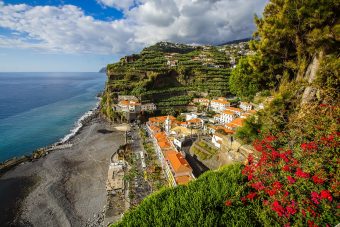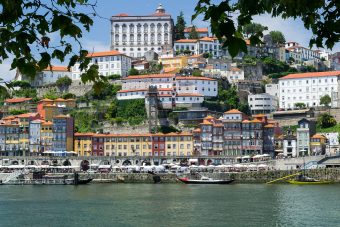
These are three major principles of Portugal’s Air Strategy, one of many adopted by the government of this country to mitigate climate change consequences and safeguard the environment. We talked to the Ambassador of Portugal to Serbia about renewable energy sources, energy efficiency, and Portugal’s green inventions that can be applied in our country.
Portugal has taken the six-month presidency of the EU Council in January, in the middle of the coronavirus pandemic. It didn’t interfere with their resolution to be an example of protecting the environment and offer a crucial contribution to the European leadership in combating climate change. The pandemic effects served only as an additional incentive on their path. The Ambassador of Portugal to Serbia, Maria Virginia Mendes da Silva Pina says that our future resilience depends on how successfully we recover from this crisis. It is time for Europe’s green and digital recovery. Portugal’s experience will be precious, as they expect a significant rise in temperature by the end of the 21 century. So, they will be closing all coal-fired power plants by the end of this year and reducing greenhouse gas emissions by 55 percent by 2030.
EP: According to the last year (2020) EPI ranking, Portugal has been at 27th place. So what are the major environmental challenges Portugal faces today?
Maria Virgínia Mendes da Silva Pina: Right now, I would say that facing the pandemic impact is our main challenge. But it will not get in the way of improving the response to the challenges in the environment, as the two are intertwined. In fact, our future resilience will depend on achieving a successful and sustainable recovery. This objective reflects one of the priorities of the Portuguese Presidency of the Council of the European Union, the promotion of Europe’s recovery, leveraged by the climate and digital transitions, that will be developed along the Green Europe action line, in which Portugal wants to act as an example contributing to Europe’s leadership in climate action, having, as an essential main goal, the approval of the First European Climate Law.
In focus:
Portugal will focus on implementing both an efficient circular economy and well-designed public policies for assuring energy transition to undercut the dependence on fossil fuels and continue the efforts to reduce C02 emissions. This also means adopting strategies of mitigation and adaptation to climate change and addressing the loss of biodiversity, as it is also a challenge that worries us. Last but not least, let me stress a most important topic for Portugal: the preservation and sustainable use of the resources of oceans and seas and the development of the blue economy.

EP: In accordance with the World Health Organization’s guidelines, the air quality in Portugal is considered safe. But available data indicates that Estarreja, Almada, Faro, and Lisbon can experience high levels of air pollution. What are Portugal’s primary air pollution sources, and how do you cope with them?
Maria Virgínia Mendes da Silva Pina: According to the State of the Environment Report, transport, industrial, and energy production are Portugal’s most extensive air pollutants. These sectors release some of the most seriously harmful compounds to human health, ecosystems, and materials into the atmosphere. The geographical areas environmental policies that contribute to the fulfillment of national and international objectives and commitments, namely those related to climate change, water resources, waste and the conservation of nature and biodiversity.
The first program is PART (Public Transport Tariff Reduction Support Program), a financial support program designed to fight negative externalities associated with mobility, namely congestion, greenhouse gas emissions, air pollution, noise, energy consumption, and social exclusion, and to reduce public transport costs by attracting passengers. The PART supports the Transport Authorities mentioned in the question are extremely urban or industrial, which means their air quality is more influenced by the above pollution problems.
Nevertheless, things are changing. For example, the most pollutant compounds in the Portuguese atmosphere have decreased approximately 38 percent since 1990. and Portugal’s National Air Strategy (ENAR2020) aims to improve air quality, protect human health, the quality of life of citizens, and the preservation of ecosystems, based on three axes: “Evaluate,” “Anticipate” and “Act.” The measures that are recommended within the ENAR 2020 framework are, therefore, thought out to achieve the air quality objectives proposed in the Clean Air Program for Europe and contribute to the Green Growth Commitment, in line with the national instruments of climate policy so that we can expect further improvement in that chapter.
EP: What are the original Portugal green inventions you are proud of in the last few years?
Maria Virgínia Mendes da Silva Pina: I would stress two programs, supported by our Ministry of Environment and Climatic Action (MAAC), that we can classify as “green examples” and that can be pursued in other countries, launched within the scope of our Environmental Fund, a financial tool created in 2016, an essential instrument for environmental policies that contribute to the fulfillment of national and international objectives and commitments, namely those related to climate change, water resources, waste and the conservation of nature and biodiversity.

The first program is PART (Public Transport Tariff Reduction Support Program), a financial support program designed to fight negative externalities associated with mobility, namely congestion, greenhouse gas emissions, air pollution, noise, energy consumption, and social exclusion, and to reduce public transport costs by attracting passengers. The PART supports the Transport Authorities with an annual budget, which allows them to operate better tariffs while adjusting its offer. PART also intends to be a tool for territorial cohesion by creating a financing model that guarantees equity between the Metropolitan Areas of Lisbon and Porto and the rest of the territory.
The second one, the Support Program to more Sustainable Buildings, implemented in 2020, aims to ensure interventions in buildings aiming at their sustainability and energy rehabilitation and can be considered a measure that has a potential multiplier effect on the economy, generating employment and wealth at the local and national level. This Program finances, throughout Portugal, all the interventions in buildings built up to 2006 that promote rehabilitation, decarbonization, energy efficiency, water efficiency, and circular economy, contributing to the improvement of the energy and their environmental performance.
EP: How is climate change affecting the life of Portuguese people and the whole Portugal environment?
Maria Virgínia Mendes da Silva Pina: All scenarios predict a significant increase in average temperature in Portugal until the end of the 21st century, together with an increase in the frequency and intensity of heat waves, that can generate droughts, increased risk of forest fires, with the alteration of land use and occupation capacities.
Considering this scenario, Portugal adopted two national strategies. First, the National Adaptation to Climate Change Strategy (ENAAC2020) envisions a country adapted to the effects of climate change by implementing a solution based on technical-scientific knowledge and good practices. Second, ENAAC 2020 defines an organizational model where coordination between the various sectors and stakeholders is promoted, pursuing priorities in thematic areas and considering the three objectives of the strategy: improvement of the level of knowledge about climate change; implementation of adaptation measures, and promotion of integration of adaptation in sectoral policies.
Second, the National Program for Adaptation to Climate Change (P-3AC) that complements and systematizes the work carried out in the context of the ENAAC 2020 and develops its second objective, the implementation adaptation measures, and that is thought out to cover several steps such as prevention of rural fires; conservation and improvement of soil fertility; efficient use of water; resilience of ecosystems; prevention of heat waves; diseases, pests, and invasive species; flood protection; coastal protection, without forgetting training, awareness, and tools for adaptation.
Interview by: Jovana Canić
Read the story in the new issue of the Energy portal Magazine WATER RESOURCES.



